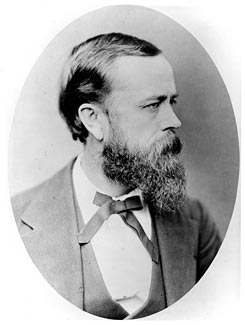- African-American History Month
- Presidents & Baseball
- Grounds and Garden
- Easter Egg Roll
- Christmas & Holidays
- State of the Union
|
Home >
History & Tours >
Eisenhower Executive Office Building
|

Alfred Bult Mullett (1834-1890)
 Alfred Bult Mullett (1834-1890) During his eight years as Supervising Architect, he oversaw the design and construction of over forty federal buildings across America. Several of these buildings are still standing, including the U.S. Mint in Carson City, NV, the U.S. Mint in San Francisco, CA, and the State, War and Navy Department Building (now the Eisenhower Executive Office Building) in Washington, D.C. Mullett resigned from his position as Supervising Architect in August 1874 to protect his honor, which he felt was under attack by Secretary of the Treasury, Benjamin Bristow, who was questioning the project's increasing costs and length of schedule to complete. The Secretaries of State, War and Navy convinced Mullett that he was not being accused of “skimming of the top,” and he delayed his resignation until December 31, 1874 when it was clear that Bristow and Mullett could not continue to work together. When the State, War and Navy Department Building was completed in 1888, Mullett
sued the U.S. government for payment of his fee for designing the building
as the commission was above and beyond his regular duties. The lower court
ruled in favor, but the U.S. government sought the higher court’s
ruling, which ruled that while Mullett was indeed the designer and was
entitled to a fee, the statute of limitations had expired. Therefore on
a technicality, Mullett lost the cast and was never paid a fee for his
largest design ever built. |


